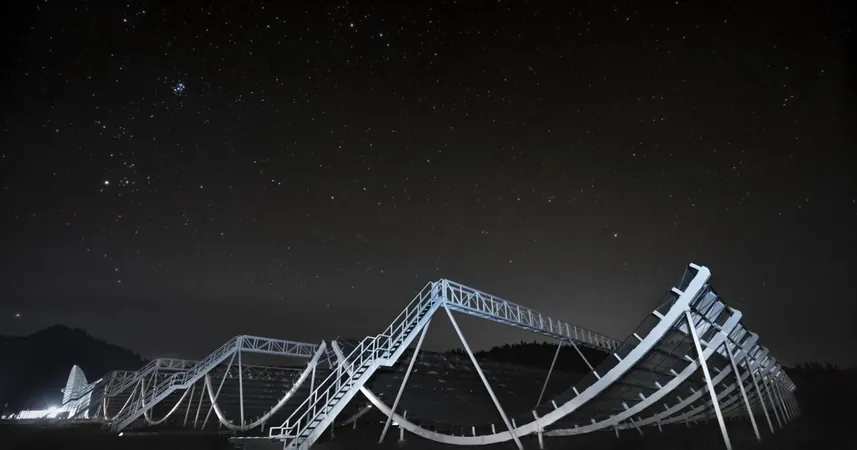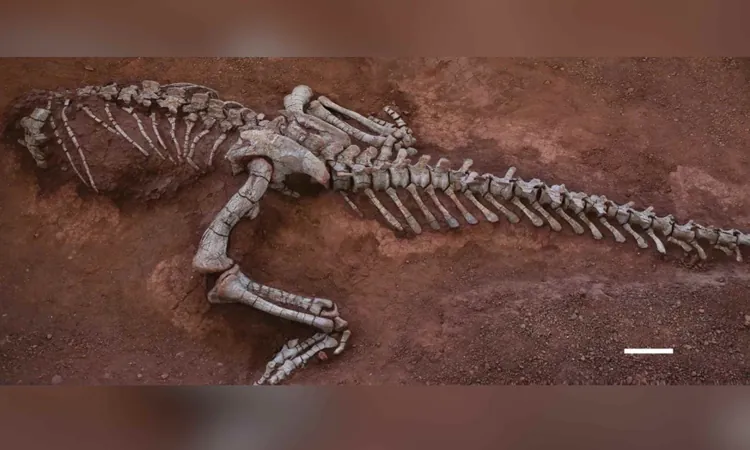
Mystifying Fast Radio Burst Found in Ancient Galaxy: A Game-Changer in Astrophysics!
2025-01-21
Author: Siti
Groundbreaking Revelation
In a groundbreaking revelation, astronomers have traced a fast radio burst (FRB) to the fringes of an ancient, dead elliptical galaxy—marking a dramatic shift in our understanding of these enigmatic cosmic events. Previously thought to be strictly products of dynamic, star-forming regions, this discovery suggests a more complex origin for FRBs.
The studies, published concurrently in the Astrophysical Journal Letters by Northwestern University and McGill University, challenge conventional theories about FRB origins. "The current belief is that FRBs originate from magnetars, which are born from core-collapse supernovae," explains Tarraneh Eftekhari from Northwestern, who spearheaded one of the studies. "However, our findings indicate that the host galaxy has no young stars, hinting at a possible subpopulation of FRBs linked to older cosmic systems."
Wen-fai Fong, a senior author of the research, noted, "This discovery serves as a reminder that the universe is full of surprises. It's this ongoing dialogue with the cosmos that fuels our passion for time-domain astronomy."
First Detection of FRB 20240209A
Astronomers first detected this extraordinary FRB, tagged FRB 20240209A, in February 2024 using the Canadian Hydrogen Intensity Mapping Experiment (CHIME). FRBs are brief, intense radio pulses; the energy they emit in just one burst can surpass what our sun produces in an entire year. Unlike typical FRBs that emerge once, this particular event threaded a remarkable tale, erupting 21 times between its initial appearance and July 2024. Remarkably, six of these additional bursts were captured by an outrigger telescope, located a short distance from CHIME, allowing researchers to determine the FRB's exact location in the cosmos.
A Colossal Host Galaxy
Upon tracking the FRB’s origins, Eftekhari and her team deployed powerful telescopes at the W.M. Keck and Gemini observatories. The results were astonishing: the FRB came from the outskirts of an 11.3-billion-year-old galaxy, situated just 2 billion light-years from Earth. "This galaxy has an immense mass—about 100 billion times that of our sun—making it the most massive FRB host galaxy identified to date," Eftekhari noted.
However, what's particularly striking is that FRB 20240209A was located 130,000 light-years from the galaxy's center in an area where new star formation is virtually non-existent. "This FRB is the farthest from the center of its host galaxy among known FRBs," stated Vishwangi Shah, a graduate student at McGill who was instrumental in determining the FRB’s origin. "This discovery raises intriguing questions about how such energetic events can arise in regions lacking active stellar formation."
A New Perspective on FRBs
Previously, only one other FRB had been documented emanating from the edge of a galaxy. The 2022 record observed an FRB linked to a dense cluster of stars at the outskirts of Messier 81, a grand spiral galaxy. Fong remarked, "The discovery of the M81 FRB prompted a re-evaluation of our understanding of FRB progenitors." Now, with FRB 20240209A potentially mirroring the M81 event, there's a growing need to rethink what's considered standard for FRB origins.
Theories Unfolding
Experts propose that FRB 20240209A may have originated in a dense globular cluster, which are known to harbor older stars and could be related to the dynamics of neutron star mergers. Shah commented, "If a globular cluster is indeed present at the FRB location, it would represent only the second known FRB residing in such a structure; if not, we must consider more extraordinary scenarios for its origin."
Eftekhari argues that this groundbreaking finding underscores the rich potential for further revelations surrounding FRBs. "This suggests that their hosting environments could be crucial to unveiling the mysteries behind these bursts," she asserted.
As scientists aim to unravel the enigmatic nature of this fast radio burst, the path ahead promises to be filled with excitement, challenges, and perhaps, even more cosmic surprises. Keep your telescopes ready—there’s much more to discover in the universe!





 Brasil (PT)
Brasil (PT)
 Canada (EN)
Canada (EN)
 Chile (ES)
Chile (ES)
 Česko (CS)
Česko (CS)
 대한민국 (KO)
대한민국 (KO)
 España (ES)
España (ES)
 France (FR)
France (FR)
 Hong Kong (EN)
Hong Kong (EN)
 Italia (IT)
Italia (IT)
 日本 (JA)
日本 (JA)
 Magyarország (HU)
Magyarország (HU)
 Norge (NO)
Norge (NO)
 Polska (PL)
Polska (PL)
 Schweiz (DE)
Schweiz (DE)
 Singapore (EN)
Singapore (EN)
 Sverige (SV)
Sverige (SV)
 Suomi (FI)
Suomi (FI)
 Türkiye (TR)
Türkiye (TR)
 الإمارات العربية المتحدة (AR)
الإمارات العربية المتحدة (AR)